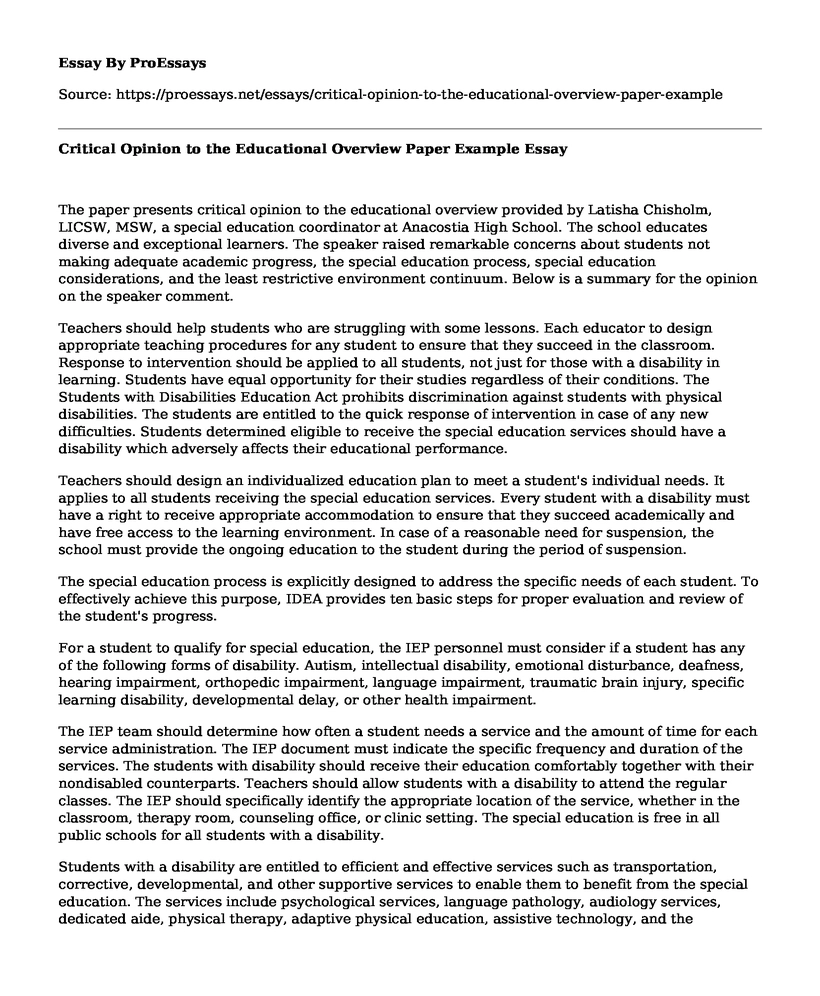The paper presents critical opinion to the educational overview provided by Latisha Chisholm, LICSW, MSW, a special education coordinator at Anacostia High School. The school educates diverse and exceptional learners. The speaker raised remarkable concerns about students not making adequate academic progress, the special education process, special education considerations, and the least restrictive environment continuum. Below is a summary for the opinion on the speaker comment.
Teachers should help students who are struggling with some lessons. Each educator to design appropriate teaching procedures for any student to ensure that they succeed in the classroom. Response to intervention should be applied to all students, not just for those with a disability in learning. Students have equal opportunity for their studies regardless of their conditions. The Students with Disabilities Education Act prohibits discrimination against students with physical disabilities. The students are entitled to the quick response of intervention in case of any new difficulties. Students determined eligible to receive the special education services should have a disability which adversely affects their educational performance.
Teachers should design an individualized education plan to meet a student's individual needs. It applies to all students receiving the special education services. Every student with a disability must have a right to receive appropriate accommodation to ensure that they succeed academically and have free access to the learning environment. In case of a reasonable need for suspension, the school must provide the ongoing education to the student during the period of suspension.
The special education process is explicitly designed to address the specific needs of each student. To effectively achieve this purpose, IDEA provides ten basic steps for proper evaluation and review of the student's progress.
For a student to qualify for special education, the IEP personnel must consider if a student has any of the following forms of disability. Autism, intellectual disability, emotional disturbance, deafness, hearing impairment, orthopedic impairment, language impairment, traumatic brain injury, specific learning disability, developmental delay, or other health impairment.
The IEP team should determine how often a student needs a service and the amount of time for each service administration. The IEP document must indicate the specific frequency and duration of the services. The students with disability should receive their education comfortably together with their nondisabled counterparts. Teachers should allow students with a disability to attend the regular classes. The IEP should specifically identify the appropriate location of the service, whether in the classroom, therapy room, counseling office, or clinic setting. The special education is free in all public schools for all students with a disability.
Students with a disability are entitled to efficient and effective services such as transportation, corrective, developmental, and other supportive services to enable them to benefit from the special education. The services include psychological services, language pathology, audiology services, dedicated aide, physical therapy, adaptive physical education, assistive technology, and the occupational therapy.
Students with a disability are entitled to appropriate support and services to demonstrate learning and access the general education curriculum validly. The accommodations involve adjustments of time to allow them to finish assignments, take a test or complete an activity. Presentations should allow students to comfortably access test directions and requires formats such as tools, read aloud, and redirections. Response accommodation allows students to comfortably record their responses to test questions in alternate ways such as the use of calculator, or scribes. Setting accommodations change the condition of the assessment setting and entail preferential seating and minimal disruption. Time accommodation changes the way time organized for testing such as involving breaks, and time allowed.
IEP should clearly describe the student's functional and academic goals for the year, identifying, skills, knowledge, and behaviors that a student should demonstrate during a year. The goal should be measurable and clear.
Students with a disability have more protections when facing discipline at school. The protections are meant to prevent students from missing many days of the learning service they richly require. The protections also secure special education students against the discriminative discipline.
Conclusion
Teachers should teach special education students in a regular class together with the nondisabled students. However, maximum support must be given to them so that they may enjoy the learning process. The law protects students with a disability against discrimination. They are entitled to the least restrictive environments. In a regular class, the collaborative team should include the occupational, physical, or speech therapists. Collaboration learning gives the students with learning disabilities free appropriate public education with specialized instruction in a regular classroom.
Cite this page
Critical Opinion to the Educational Overview Paper Example. (2022, Jun 19). Retrieved from https://proessays.net/essays/critical-opinion-to-the-educational-overview-paper-example
If you are the original author of this essay and no longer wish to have it published on the ProEssays website, please click below to request its removal:
- The Impact of International Studies in Faculty Development
- Should Students Use Laptops in Class? Essay Sample
- The Economic Plight of the Afghans in Australia Reflection Essay Example
- Essay Sample on Good Parenting and Teaching
- Essay Example on ACE Score & Its Impact on Future Mental & Physical Health
- Research Paper Sample on Unlock Student Potential With Innovative Teaching: A Study of Biology Learning
- Free Report Sample on MBTI: Purpose, Construct, Strengths & Weaknesses







